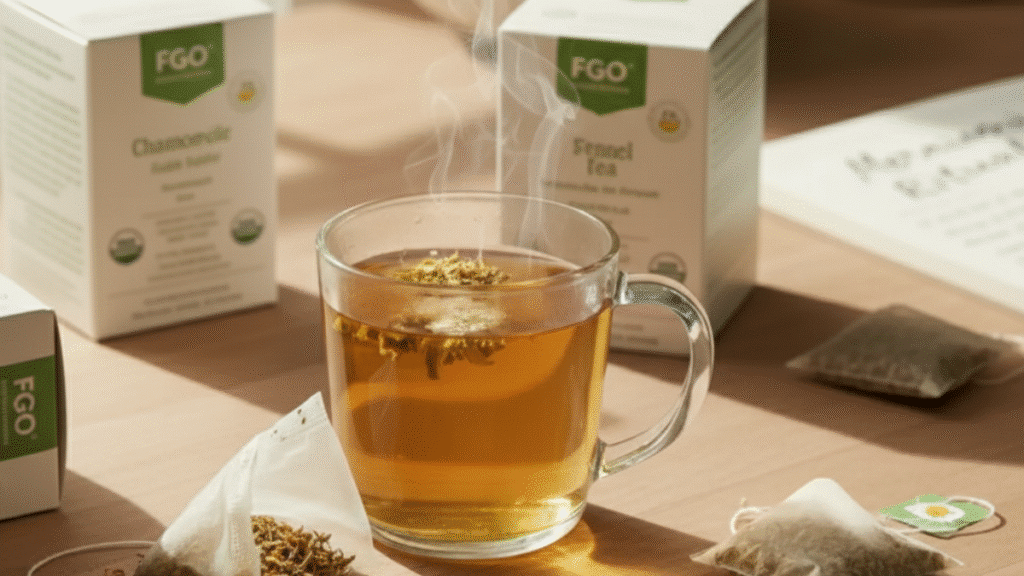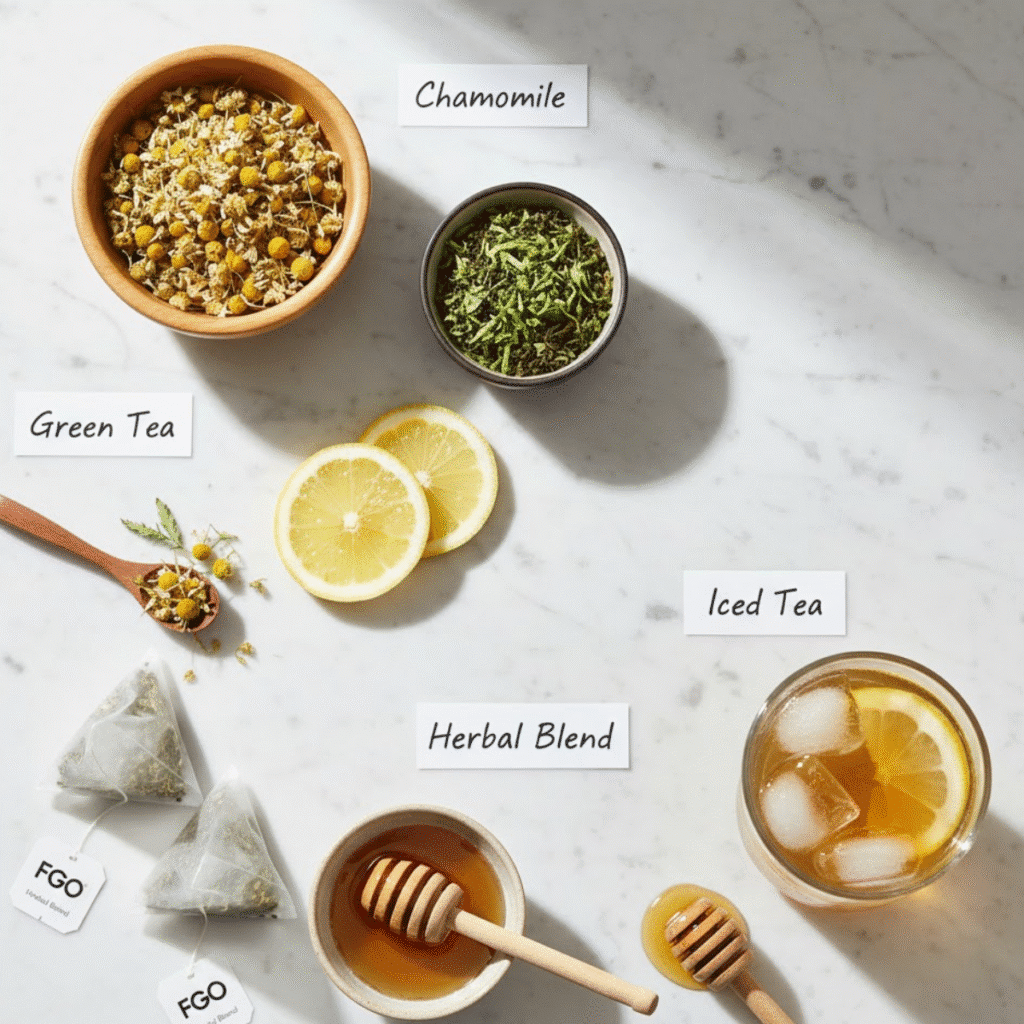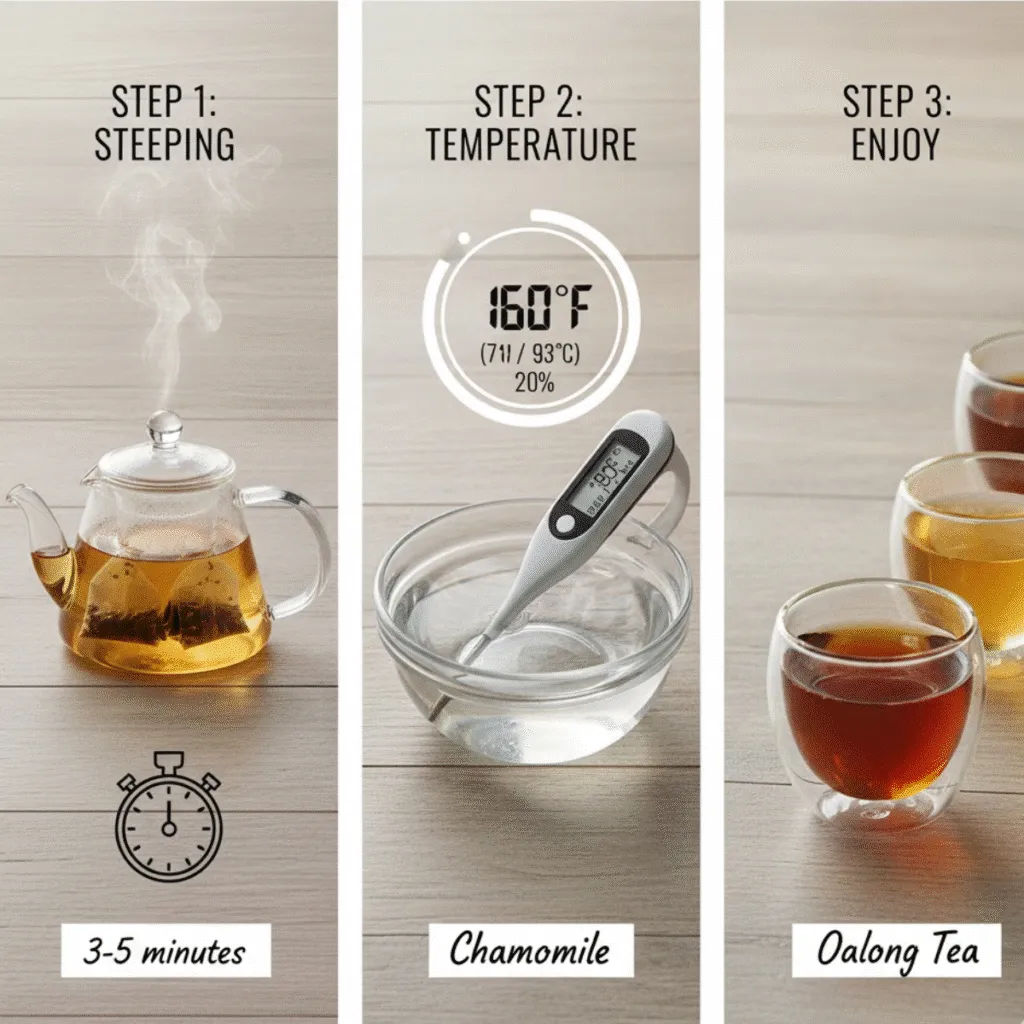
Let me start with a confession: I used to roll my eyes at the idea that a simple cup of tea could make any real difference in my wellness journey. That was before I discovered FGO tea during one of those late-night research sessions when I was trying to find natural ways to support my weight management goals.
You’ve probably seen the headlines claiming “green tea is the new Ozempic.” Honestly? That kind of hyperbole drives me crazy. But here’s what I have discovered after three months of incorporating FGO organic tea into my daily routine—and diving deep into the actual science behind it.
Key Takeaways: What You Need to Know About FGO Tea
- FGO tea is USDA organic and non-GMO certified, offering genuine quality without inflated marketing claims
- The catechins and EGCG in FGO green tea have documented metabolic benefits, but they’re supportive tools—not miracle workers
- FGO tea caffeine content varies significantly by variety (0-50mg per cup), making it easy to customize to your needs
- Compared to competitors, FGO offers better value and cleaner ingredients, though brewing method matters more than brand for results
- When combined with lifestyle changes (like my pink salt weight loss recipe), tea becomes part of an effective holistic approach
Table of Contents
What Actually Makes FGO Tea Different From Other Brands?
Here’s the thing about the tea market—it’s absolutely flooded with brands making bold promises. So when I first encountered FGO organic tea, I approached it with healthy skepticism.
What caught my attention wasn’t flashy marketing. It was the straightforward approach: USDA organic certification, non-GMO verification, and a surprisingly transparent ingredient list. No “proprietary blends” hiding who-knows-what. Just real tea.
The FGO brand focuses on single-origin, whole-leaf teas packaged in convenient FGO tea bags. You’ll find everything from FGO chamomile tea for those restless nights to robust oolong tea and delicate white tea varieties. Each brings its own profile of polyphenols and catechins—compounds we’ll dig into shortly.
What I particularly appreciate is that FGO tea pods aren’t available (yet?), which actually speaks to their commitment to quality. Those single-serve pods often compromise tea quality for convenience. FGO hasn’t gone that route.
The Real Science: How Green Tea Compounds Actually Work
Okay, let’s talk about what’s actually happening inside your body when you drink green tea. No mystical claims here—just biochemistry.
The star players are catechins, particularly one called EGCG (epigallocatechin gallate). Think of EGCG as the tea world’s overachiever. Research has shown it can influence metabolic processes enough that the FDA has even designated certain green tea-derived compounds for medical research.
But here’s where I need you to hear me clearly: these polyphenols don’t magically melt fat away. What they do support is:

Fat oxidation during exercise—meaning your body may become slightly more efficient at using stored fat for energy. It’s subtle, not dramatic.
Appetite regulation—some people (myself included) notice feeling more satisfied between meals. The mechanism isn’t entirely clear, but it seems related to how catechins interact with our hunger hormones.
Digestion and metabolism support—not a metabolic “boost” in the sensational sense, but gentle optimization of how your body processes food.
The caffeine content in FGO green tea (typically 25-50mg per cup) works synergistically with EGCG. Together, they create a more sustained energy experience than coffee’s quick spike and crash.
FGO Tea vs. The Competition: An Honest Comparison
I’ve tested a lot of organic tea brands over the past year. Here’s how FGO stacks up against the major players:
| Brand | Organic Certified | Price per Bag | Caffeine (Green Tea) | Pros | Cons |
|---|---|---|---|---|---|
| FGO | ✓ USDA | $0.18-0.25 | 30-50mg | Best value, clean ingredients, whole leaf quality | Less variety than specialty brands |
| Traditional Medicinals | ✓ USDA | $0.35-0.45 | 25-40mg | Excellent herbal blends, pharmacy-trusted | Higher price point |
| Yogi Tea | Partially | $0.28-0.38 | 20-35mg | Creative flavor combinations | Added ingredients, not all organic |
| Numi | ✓ USDA | $0.40-0.55 | 35-55mg | Premium sourcing, beautiful packaging | Premium pricing |
| Twinings | ✗ | $0.15-0.22 | 20-30mg | Widely available, consistent | Not organic, lower catechin content |
The bottom line? FGO tea offers the best balance of quality and affordability. You’re getting genuinely organic, whole-leaf tea without paying for elaborate packaging or celebrity endorsements.
However—and this is important—the difference between premium organic teas comes down to personal preference more than measurable health outcomes. Your brewing method matters more than whether you choose FGO or Numi.
Green Tea as “The New Ozempic”? Let’s Get Real
I promised honesty, so here it is: No, green tea is not the new Ozempic.
That viral comparison frustrates me because it creates unrealistic expectations. Ozempic (semaglutide) is a pharmaceutical drug that directly affects GLP-1 receptors, leading to significant appetite suppression and weight loss in clinical trials. We’re talking 10-15% body weight reduction for many users.

Green tea? The studies showing weight loss typically report 1-3 pounds over 12 weeks. That’s with dietary changes and exercise.
So why even bother with tea?
Because holistic wellness isn’t about finding one magic solution. It’s about creating sustainable habits that support your goals. When I drink FGO organic green tea before my morning workout, it genuinely seems to help with energy and focus. When I sip FGO chamomile tea before bed, I sleep better—which we know impacts weight management through cortisol regulation.
If you’re exploring natural alternatives to pharmaceutical interventions, you might also be interested in my natural Mounjaro recipe, which takes a food-first approach to supporting metabolic health.
Which Tea Burns the Most Belly Fat? (And Why This Question Misses the Point)
Let me address this head-on because it’s one of the most common questions I get.
The research suggests green tea and oolong tea have the highest concentrations of catechins that may support fat oxidation. But “burns belly fat” is misleading language.
Your body doesn’t selectively burn fat from specific areas based on what you drink. Belly fat reduction happens through overall fat loss, which requires a caloric deficit—ideally achieved through whole-food nutrition and movement.
What tea can do:
Replace high-calorie beverages. Swapping a 200-calorie latte for FGO tea saves you 1,400 calories weekly—that’s real impact.
Support appetite management. I find that drinking tea between meals helps me distinguish between actual hunger and boredom eating.
Provide a ritual that supports your goals. The act of brewing and mindfully drinking tea creates a pause—a moment to check in with your body rather than mindlessly snacking.
I’ve combined my tea ritual with simple, evidence-based approaches like my pink salt recipe for weight loss, and together they create a sustainable approach that doesn’t feel restrictive.
How to Actually Choose and Brew FGO Tea (The Details That Matter)
Here’s what three months of daily tea drinking has taught me about getting the most from FGO tea varieties:
Choosing Your FGO Tea
For metabolism support and energy: Go with FGO organic green tea. The catechin content is highest, and the moderate caffeine (30-50mg) provides gentle stimulation without jitters.
For evening relaxation: FGO chamomile tea is genuinely caffeine-free and contains apigenin, a compound that may help with sleep quality. I’ve noticed a real difference in how quickly I fall asleep.
For a middle ground: Try white tea or oolong tea. They offer antioxidant benefits with lower caffeine than green tea. Oolong is particularly interesting because it’s partially oxidized, giving you a flavor profile between green and black tea.
For digestive support: Look into their herbal blends. While not true “tea” (they’re not from the Camellia sinensis plant), herbs like peppermint and ginger support digestion and are naturally caffeine-free.
Brewing Method (This Actually Matters)
Here’s where most people go wrong: they either use boiling water or steep too long, resulting in bitter, astringent tea that masks the beneficial compounds.
For FGO tea bags, I follow this approach:
Green and white teas: Heat water to 160-180°F (just before boiling), steep 2-3 minutes. This preserves catechins while minimizing bitterness.
Oolong tea: 185-195°F, steep 3-4 minutes. Oolong can handle slightly hotter water.
Herbal teas: Full boiling water (212°F), steep 5-7 minutes. You want full extraction of the herbal compounds.
Pro tip: If you’re brewing for metabolism support, drink your FGO green tea about 30 minutes before exercise. Some research suggests this timing maximizes the fat oxidation benefits during your workout.
Tea Bags vs. Loose Leaf: Does It Matter?
Purists will tell you loose leaf is always superior. In practice? FGO tea bags contain quality whole-leaf tea, not the “dust and fannings” found in cheaper brands. The convenience factor means I actually drink tea daily, rather than buying fancy loose-leaf that sits unused.
That said, if you’re brewing FGO iced tea in larger batches, loose leaf makes more sense economically and allows better control over strength.
My Real Experience: What Actually Changed After 90 Days
I’m going to be completely transparent about my experience because I think genuine testimonials are more valuable than exaggerated claims.
What changed:
My afternoon energy is more stable. I used to hit a 3 PM wall that had me reaching for sugary snacks. Now I brew a cup of FGO organic green tea around 2:30, and I genuinely don’t experience that same crash.
My digestion improved noticeably. I can’t say definitively if it’s the tea or the fact that I’m drinking more fluids overall, but bloating has decreased significantly.
I lost about 4 pounds—but I also adjusted my eating habits and increased my walking. The tea was part of a holistic shift, not a standalone solution.

What didn’t change:
I didn’t experience dramatic appetite suppression. Some people report feeling significantly less hungry after drinking green tea; I noticed only a subtle difference.
My weight loss wasn’t rapid. Four pounds in three months is slow by social media standards, but it’s sustainable and hasn’t required deprivation.
The tea alone didn’t transform my body. It supported better choices, but it wasn’t magic.
Important Safety Considerations and Medication Interactions
Before you stock up on FGO tea from Amazon (where it’s readily available with good buying tips in the reviews), let’s talk about safety and potential medication interactions.
Green tea is generally safe for most people, but the catechins can interact with certain medications:
Blood thinners: Vitamin K in green tea may affect warfarin effectiveness. If you’re on blood thinners, consult your doctor before drinking multiple cups daily.
Stimulant medications: The caffeine in FGO tea can amplify effects of ADHD medications or other stimulants, potentially causing jitteriness or elevated heart rate.
Iron absorption: Catechins can inhibit iron absorption. If you have anemia, drink your tea between meals rather than with iron-rich foods.
Liver considerations: While rare, excessive green tea extract supplements (not regular brewed tea) have been associated with liver issues. Stick to reasonable amounts—2-4 cups daily.
Personally, I drink 2-3 cups of caffeinated FGO tea in the morning and early afternoon, then switch to caffeine-free herbal varieties in the evening. This prevents any sleep disruption while maximizing the metabolic benefits during active hours.
The Bottom Line: Is FGO Tea Worth It?
After three months of daily use and extensive research into the actual science, here’s my honest assessment: FGO tea is absolutely worth incorporating into your wellness routine—with realistic expectations.
This isn’t a weight-loss miracle. It’s not going to replace a pharmaceutical intervention if you need one. But as part of a holistic approach to health? The organic certification, clean ingredients, reasonable pricing, and genuine (if modest) metabolic benefits make it a smart choice.
What I appreciate most is that FGO doesn’t make outrageous claims. They’re selling quality tea at fair prices, and sometimes that straightforward approach is exactly what we need in a market saturated with wellness hype.
If you’re ready to upgrade your beverage choices and want to support your wellness goals with something backed by actual research, start with FGO organic green tea in the morning and FGO chamomile tea in the evening. Give it 30 days before judging results—sustainable changes take time.
And remember, tea is most effective as part of a broader lifestyle approach. Pair it with whole-food nutrition, regular movement, and adequate sleep. Those fundamentals matter more than any single food or beverage ever could.
Frequently Asked Questions About FGO Tea
Is FGO a good tea brand?
Yes, FGO is a good tea brand, particularly if you prioritize organic certification and value. I’ve found their quality consistent across multiple varieties—the FGO organic green tea tastes clean without the grassy bitterness some cheaper brands have. The USDA organic and non-GMO certifications provide genuine assurance about what you’re not getting (pesticides, GMOs, artificial additives).
Where FGO stands out is in the price-to-quality ratio. You’re not paying for celebrity endorsements or elaborate marketing campaigns. That said, if you want exotic, rare tea varieties or you’re a serious tea connoisseur, specialty tea shops might offer more selection. But for daily wellness support? FGO is absolutely solid.
Who owns FGO tea?
FGO (Full Great Origin) is owned by a company called Teatulia, which is based in Colorado. What’s interesting about their business model is the focus on direct-trade relationships with tea gardens. This allows them to maintain quality control while keeping prices reasonable.
They’re not a massive conglomerate like Unilever (which owns Lipton) or Tata (which owns Tetley). This mid-size positioning means they can focus on organic certification and sustainable sourcing without the bureaucracy of huge corporations. From what I’ve researched about their buying tips and company practices, they seem genuinely committed to quality over market dominance.
Is green tea really the new Ozempic?
No, and this comparison is irresponsible health journalism at its worst. Let me be crystal clear: green tea is not the new Ozempic.
Ozempic (semaglutide) is a GLP-1 receptor agonist that produces significant, documented weight loss—often 10-15% of body weight—through direct hormonal mechanisms. Green tea contains catechins and EGCG that may support modest metabolic benefits, typically resulting in 1-3 pounds of additional weight loss over several months when combined with lifestyle changes.
The comparison exists because both have metabolic effects, but the magnitude is completely different. Think of it this way: Ozempic is a prescription medication with powerful effects and potential side effects. Green tea is a beverage with subtle supportive benefits and minimal risks.
If you’re exploring natural alternatives to pharmaceutical weight loss interventions, tea should be one component of a comprehensive approach—not a replacement for medical treatment when medically necessary.
Which tea burns the most belly fat?
The premise of this question reflects a common misconception about how fat loss works. No tea specifically “burns belly fat“—your body doesn’t selectively metabolize fat from specific areas based on what you consume.
That said, research suggests green tea and oolong tea have the highest concentrations of catechins and EGCG, which may support overall fat oxidation during exercise. Studies show green tea drinkers who exercise regularly experience slightly enhanced fat burning compared to non-tea drinkers doing the same exercise.
The “best” tea for weight loss is ultimately the one you’ll drink consistently as part of a caloric deficit and active lifestyle. For me, that’s been FGO organic green tea in the morning for its metabolism-supporting compounds, and FGO chamomile tea at night to improve sleep quality (which indirectly supports weight management through better cortisol regulation).
Focus less on “fat-burning” teas and more on replacing high-calorie beverages with unsweetened tea, supporting your body’s natural processes through adequate hydration, and creating sustainable habits you can maintain long-term.

I really like how this recipe captures the essence of FGOs Tea, making it feel special and cozy. It’s a creative way to connect with the game’s world in real life.
Thank you 🙂